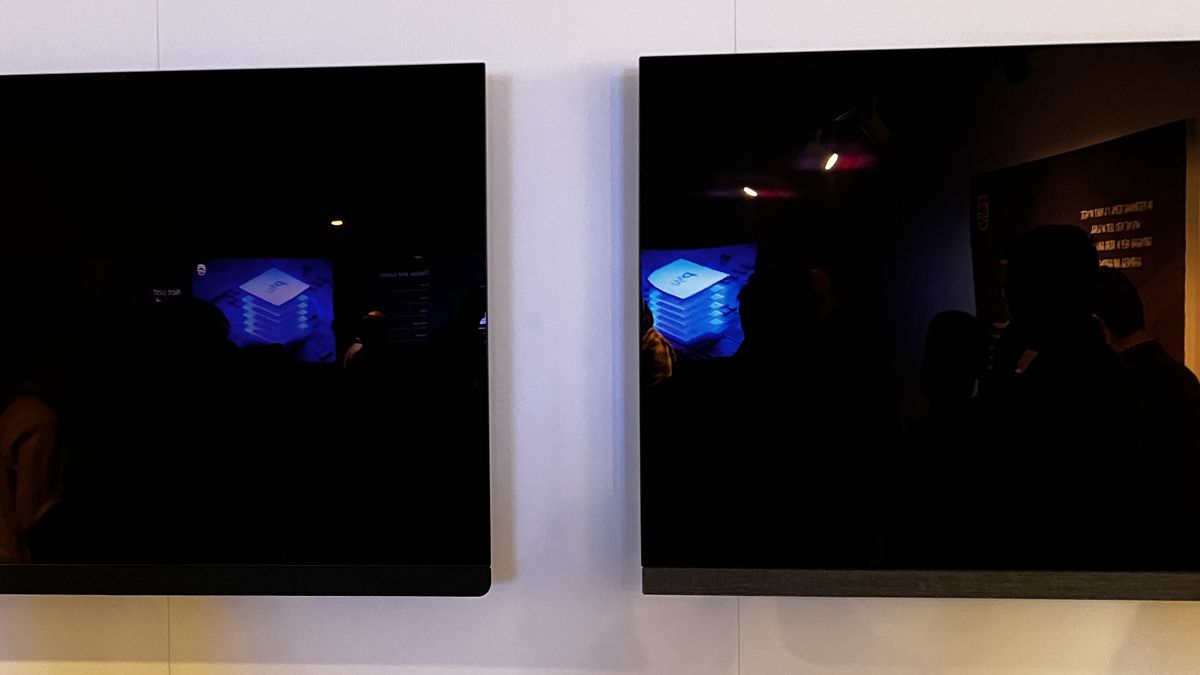Beating reflections could be the next big leap forward for more affordable 4K TVs
Technology such as LG Display’s reflection-killing Vanta Black is amazing, but the TVs that would benefit most from it are the cheaper models

Reflections suck. Unless you happen to be Timothée Chalamet, they’re not want to you want to see from your TV instead of the actual picture. Even if you own one of the brightest and best 4K TVs, if you’re watching content in a sun-filled room, reflections can absolutely kill the viewing experience.
That goes double if your TV's brightness isn't very high, which tends to be true of mid-range or cheaper sets, as well as many of the best OLED TVs.
Historically, screen makers (especially in PC monitors) have deployed screens with matt finishes when trying to limit reflectivity. While this is an effective technique, it also comes with a major caveat: matt screens limit brightness, and can reduce perceived sharpness. That’s why LG Display’s new ‘Vanta Black’ polarizer could potentially be such a game-changer. We've seen it in person, and not only does it have a huge impact on how much light a TV reflects, it does so without dampening the brightness of the picture. You can see the difference (with a black screen) at the top of this page – look at how the screen being reflected is so much dimmer on the left, and how less invasive the reflection of the spotlights are.
There is a catch with Vanta Black, though. While it’s an undeniably impressive tech – one that wowed us when we saw the impressive Philips OLED+908 – it’s currently only being rolled out in certain high-end TVs.
Back in Black
The Vanta Black polarizer is housed in not only the Philips OLED+908, but also the upcoming Panasonic MZ2000 OLED and the LG G3 OLED. With all three TVs boasting the '3rd Gen OLED Panel' from LG Display that also includes Micro Lens Array (MLA) tech, which is set to dramatically boost picture brightness, these OLEDs are at the cutting edge of television tech in 2023. As such, they’re set to be expensive. Really expensive.
Unless you’re willing to drop north of two grand on a new 55-inch OLED with MLA, you’re not going to experience the reflection-killing magic of Vanta Black anytime soon. That’s a real shame, because the benefits of the polarizer could have a huge impact on the sort of mid-range 4K TVs that most people are actually looking to buy.

While Micro Lens Array tech is hugely exciting, limiting reflections can be every bit as impactful to a real-world viewing experience as raising brightness – and it could be much cheaper than building in bleeding-edge pixels. Before the Samsung S95B QD-OLED hit stores last year – turning in a brighter picture than any previous OLED we’d ever tested thanks to its quantum dot filter – traditional OLEDs had long struggled with brightness issues.
As someone who watches movies in a bright room with large patio-style windows, I’m frequently forced to look at my own pale visage being reflected back at me. My LG C2 OLED may be one of the best OLED TVs you can buy, but it could benefit big-time from the Vanta Black polarizer, or something equivalent.
The Samsung-made QD-OLED panels found in the Samsung S95C and Sony A95L also promise lower reflections than the previous version, though we've yet to really assess that.
And that’s talking about some seriously premium panels. Just imagine the impact this kind of tech could have on more affordable screens that can’t come close to the LG C2’s HDR performance. With the addition of something similar to stamp down on reflections, mid-range TVs could look brighter without actually needing to be brighter and, therefore, more expensive.
A time to reflect
Whether limiting screen reflections is achieved via Vanta Black or an alternative polarizer, reducing reflectivity could be transformative for budget-friendly TVs going forward. Combating light pollution is one of the biggest challenges AV enthusiasts have to tackle, and any solution that doesn’t involve blackout blinds is a winner in my book.
With global electricity prices continuing to skyrocket and the European Union placing stricter power consumption regulations on new TVs, manufacturers need to come up with methods of boosting brightness that isn’t dependent on pumping in more energy to make brighter panels (though I should note that the '3rd Gen OLED Panels' are actually more efficient than what's come before).
If LG Display or other manufactures can bring a version of Vanta Black or similar reflection-slaying features to a wide range of mid-range TVs, it could transform the market. The notion of a future generation of affordable screens that severely limit reflections without being blighted by matt finishes is an exciting prospect.
Let’s hope a form of Vanta Black or a similarly effective reflection-limiting tech hits the best TVs on the market en masse soon. I understand why tech like this would be introduced at the top end of the market, but it's not where it's needed the most. The day when I’m no longer forced to look at my stupid face on my TV screen can’t get here quickly enough.
Get daily insight, inspiration and deals in your inbox
Sign up for breaking news, reviews, opinion, top tech deals, and more.
Dave is a freelancer who's been writing about tech and video games since 2006, with bylines across GamesRadar+, Total Film, PC Gamer, and Edge. He's been obsessed with all manner of AV equipment ever since his parents first bought him a hideously garish 13-inch CRT TV (complete with built-in VCR, no less) back in 1998. Over the years he’s owned more plasma and OLED TVs than he can count. On an average day, he spends 30% of his waking existence having mild panic attacks about vertical banding and dead pixels.
Most Popular

